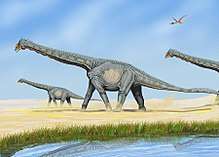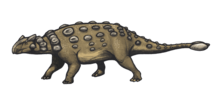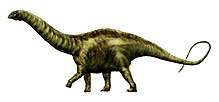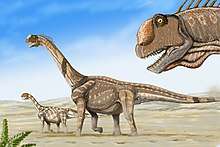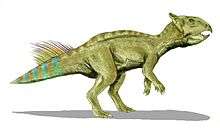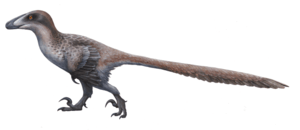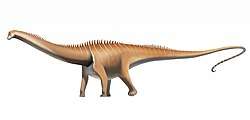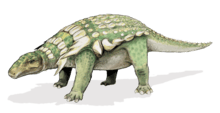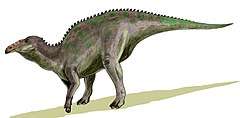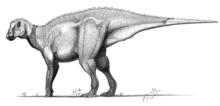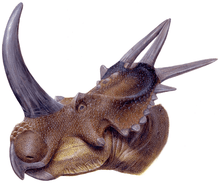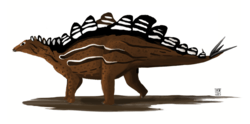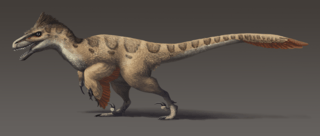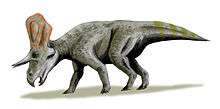List of North American dinosaurs
This is a list of dinosaurs whose remains have been recovered from North America. North America has a rich dinosaur fossil record with great diversity of dinosaurs.
History
The earliest record of dinosaurs in North America comes from rare, unidentified (possibly theropod) footprints and teeth in the Middle-Late Triassic Pekin Formation of North Carolina.[1] Later in the Triassic period, dinosaurs left more recognizable remains, and could thus be identified as specific genera. Examples of later Triassic North American dinosaur genera include Coelophysis, Chindesaurus, Gojirasaurus, and Tawa. Fossils of Tawa-like dinosaurs have also been found in South America, which has important indications about paleogeography. During the Early Jurassic Period, dinosaurs such as Dilophosaurus, Anchisaurus, Coelophysis (formerly known as Megapnosaurus), and the early thyreophoran Scutellosaurus lived in North America. The latter is believed to have been the ancestor of all stegosaurs and ankylosaurs. The Middle Jurassic is the only poorly represented time period in North America, although several Middle Jurassic localities are known from Mexico. Footprints, eggshells, teeth, and fragments of bone representing theropods, sauropods, and ornithopods have been found, but none of them are diagnostic to the genus level.
The Late Jurassic of North America, however, is the exact opposite of the Middle Jurassic. The Late Jurassic Morrison Formation is found in several U.S. states, including Colorado, Utah, Wyoming, Montana, New Mexico, Oklahoma, South Dakota, and Texas. It is notable as being the most fertile single source of dinosaur fossils in the world. The roster of dinosaurs from the Morrison is impressive. Among the theropods, Allosaurus, Saurophaganax, Torvosaurus, Ceratosaurus, Coelurus, Ornitholestes, Tanycolagreus, Stokesosaurus, and Marshosaurus are found in the Morrison. An abundance of sauropods has been found there, including Apatosaurus, Diplodocus, Barosaurus, Brachiosaurus, Camarasaurus, Brontosaurus and Amphicoelias. Three genera of stegosaurs, Alcovasaurus, Stegosaurus and Hesperosaurus, have been found there. Finally, ornithopods found in the Morrison include Dryosaurus, Camptosaurus, Drinker, Othnielia, and Othnielosaurus.
During the Early Cretaceous, new dinosaurs evolved to replace the old ones. Sauropods were still present, but they were not as diverse as they were in the Jurassic Period. Theropods from the Early Cretaceous of North America include dromaeosaurids such as Deinonychus and Utahraptor, Acrocanthosaurus, and Microvenator. Sauropods included Astrodon, Brontomerus, and Sauroposeidon. Ornithischians were more diverse than they were in the Jurassic Period. Tenontosaurus, Dakotadon, Protohadros, and Eolambia are some of the ornithopods that lived during this time period. Ankylosaurs replaced their stegosaur cousins in the Cretaceous. Ankylosaurs from the Early Cretaceous of North America include Sauropelta and Gastonia. Therizinosaurs such as Falcarius are also known from the Early Cretaceous of North America.
Finally, during the Late Cretaceous Period, the greatest abundance and diversity of dinosaurs of all time lived in North America. During the early part of the Late Cretaceous, the therizinosaur Nothronychus and the ceratopsian Zuniceratops lived. During the Campanian stage of the Late Cretaceous, an enormous diversity of dinosaurs is known. Theropods included the tyrannosaurs Albertosaurus, Gorgosaurus, Daspletosaurus, Teratophoneus, Bistahieversor, and Appalachiosaurus, and the dromaeosaurids Dromaeosaurus, Saurornitholestes, Atrociraptor, and Bambiraptor. Ceratopsians, such as Pachyrhinosaurus, Styracosaurus, Centrosaurus, Monoclonius, Brachyceratops and Pentaceratops also existed. Among hadrosaurs, Hypacrosaurus, Gryposaurus, Kritosaurus, Parasaurolophus, Corythosaurus, Lambeosaurus and Prosaurolophus existed. During the latest Cretaceous, the Maastrichtian age, the diversity of dinosaurs saw a decline from the preceding Campanian stage. North American herbivorous dinosaurs from this time period include the titanosaur sauropod Alamosaurus, the ceratopsians Bravoceratops, Regaliceratops, Triceratops, Leptoceratops, Torosaurus, Nedoceratops, Tatankaceratops (the latter two possible species of Triceratops), and Ojoceratops, the pachycephalosaurs Pachycephalosaurus, Stygimoloch, Dracorex, and Sphaerotholus, the hadrosaurs Augustynolophus, Saurolophus and Edmontosaurus, the ornithopod Thescelosaurus the ankylosaur Ankylosaurus and the nodosaurs Denversaurus, Glyptodontopelta and Edmontonia. Predatory dinosaurs from this time period included the tyrannosaurids Tyrannosaurus, Nanotyrannus (which may just be a juvenile of the former) and Dryptosaurus, the ornithomimids Ornithomimus , Dromiceiomimus, Struthiomimus, the oviraptorids Anzu, Leptorhynchos and Ojoraptorsaurus, the troodontids Pectinodon, Paronychodon and Troodon, the coelurosaur Richardoestesia and the dromaeosaurs Acheroraptor and Dakotaraptor.
The only dinosaur fossil from Central America currently is a femur of an ornithopod.,[2][3] discovered in the central part of Honduras in the year 1971 near San Luis, Comayagua Department, by Bruce Simonson and Gregory Horne. It was found in the highest part of the Valle de Angeles Redbeds. The fossil bone is in the US National Museum of Natural History in Washington (catalog number USNM PAL 181339). It was identified as ornithopod bone by John Ostrom,[3] and by Nicholas Hotton as the right femur of a small hadrosaur.[4]
There is also an older report of dinosaur fossil from Honduras documented only in US newspapers at 1933, but not scientifically documented . This report comments the discovery of a dinosaur ankle bone near the town of Olanchito, Yoro Department, Honduras; by the explorer Gregory Mason. This information is described on page 9 of The Washington Post of August 23, 1933, on page 8 of the newspaper The Norwalk Hour August 24, 1933[5] and on page 6 of Nebraska newspaper The Plattsmouth Journal of August 21 of 1933[6]
Criteria for inclusion
Inclusion criteria:
- The creature must appear on the List of dinosaur genera.
- Fossils of the creature must have been found in North America.
- This list is a complement to Category:Dinosaurs of North America.
List
| Nomen dubium |
| Invalid |
| Nomen nudum |
| Name | Period | Diet[7] | State (Country) | Notes |
|---|---|---|---|---|
| Abydosaurus | Cretaceous | herbivore | USA | Last known sauropod in North America until appearance of Alamosaurus |
| Achelousaurus | Cretaceous | herbivore | USA | A "transitional form" between two other species of ceratopsians. |
| Acheroraptor | Cretaceous | carnivore | USA | One of the last dromaeosaurs. |
| Acristavus | Cretaceous | herbivore | USA | An early hadrosaur with no crest on its snout. |
| Acrocanthosaurus | Cretaceous | carnivore | USA | A large predator with a hump or sail on its back. |
| Acrotholus | Cretaceous | herbivore | Canada | North America's oldest pachycephalosaur. |
| Agathaumas | Cretaceous | herbivore | USA | Dubious, see article |
| Agujaceratops | Cretaceous | herbivore | USA | Formerly a species of Chasmosaurus. |
| Ahshislepelta | Cretaceous | herbivore | USA | An ankylosaur. |
| Akainacephalus | Cretaceous | herbivore | USA | A recently described well-preserved ankylosaur. |
| Alamosaurus | Cretaceous | herbivore | Texas (USA) | The last known sauropod from North America. |
| Alaskacephale | Cretaceous | herbivore | Alaska (USA) | A pachycephalosaur. |
| Albertaceratops | Cretaceous | herbivore | Alberta (Canada) | A basal centrosaurine ceratopsian. Montanan specimen reclassified as Medusaceratops |
| Albertadromeus | Cretaceous | herbivore | Canada | A small ornithischian. |
| Albertonykus | Cretaceous | carnivore/insectivore | Canada | One of North America's smallest adult non-avian dinosaurs. |
| Albertosaurus | Cretaceous | carnivore | Canada | Fossil evidence suggests it may have hunted in packs. |
| Alcovasaurus | Jurassic | herbivore | USA | Formerly a species of Stegosaurus and Natronasaurus. |
| Aletopelta | Cretaceous | herbivore | USA | Its remains were found in California, thought it may have lived closer to Mexico in life. |
| Allosaurus | Jurassic | carnivore | Colorado, Montana, New Mexico, Kansas, Nebraska, Arizona, Idaho, Texas, North Dakota,Oklahoma, South Dakota, Utah, Wyoming (USA) Portugal & Tanzania | As one of the first well-known theropod dinosaurs, it has long attracted attention outside of paleontological circles. Fossils also found in Europe & Africa. |
| Amphicoelias | Jurassic | herbivore | USA | A sauropod. |
| Anasazisaurus | Cretaceous | herbivore | USA | Intertwined with Gryposaurus and Kritosaurus throughout its history. |
| Anchiceratops | Cretaceous | herbivore | Alberta (Canada) | A ceratopsian. |
| Anchisaurus | Jurassic | herbivore | USA | A small basal sauropodomorph. |
| Angulomastacator | Cretaceous | herbivore | USA | A hadrosaur with an unusually-shaped jaw. |
| Animantarx | Cretaceous | herbivore | USA | Discovered during a radiological survey of the fossil site. |
| Ankylosaurus | Cretaceous | herbivore | Montana (USA) | Known for its heavily armored back. |
| Anodontosaurus | Cretaceous | herbivore | Canada | Formerly congeneric with Euoplocephalus. |
| Antrodemus | Jurassic | carnivore | Probably synonymous with Allosaurus, see article | |
| Anzu | Cretaceous | omnivore | USA | A large oviraptorosaur. |
| Apatodon | Jurassic | carnivore | USA | Highly dubious, see article |
| Apatosaurus | Jurassic | herbivore | Colorado, Oklahoma, New Mexico, Utah (USA) | Formerly congeneric with Brontosaurus |
| Appalachiosaurus | Cretaceous | carnivore | USA | One of the few non-avian dinosaurs from the eastern side of North America. |
| Aquilarhinus | Cretaceous | herbivore | USA | A hadrosaur from Big Bend National Park in Texas, described in 2019. |
| Arkansaurus | Cretaceous | omnivore | USA | A nomen nudum for 41 years before being officially described in 2018. |
| Arrhinoceratops | Cretaceous | herbivore | Canada | A ceratopsian. |
| Astrodon | Cretaceous | herbivore | USA | State dinosaur of Maryland. |
| Astrophocaudia | Cretaceous | herbivore | USA | A sauropod. |
| Atlantosaurus | Jurassic | herbivore | USA | Probably the same as Apatosaurus. |
| Atrociraptor | Cretaceous | carnivore | Canada | A close relative of Saurornitholestes. |
| Augustynolophus | Cretaceous | herbivore | USA | State dinosaur of California. |
| Aublysodon | Cretaceous | carnivore | USA | Dubious, see article. |
| Avaceratops | Cretaceous | herbivore | USA | A small ceratopsian. |
| Bambiraptor | Cretaceous | carnivore | USA | Named after the familiar character due to its small size. |
| Barosaurus | Jurassic | herbivore | USA | Probably one of the largest dinosaurs. |
| Beelemodon | Jurassic | carnivore | USA | Possibly a coelurosaur. |
| Bistahieversor | Cretaceous | carnivore | USA | A tyrannosaur. |
| Brachiosaurus | Jurassic | herbivore | USA | A familiar sauropod. |
| Brachyceratops | Cretaceous | herbivore | USA | Only juvenile fossils found so far |
| Brachylophosaurus | Cretaceous | herbivore | USA and Canada | A hadrosaur known from several well-preserved "mummies" |
| Bravoceratops | Cretaceous | herbivore | USA | A large ceratopsian. |
| Brontomerus | Cretaceous | herbivore | USA | Possibly dubious. |
| Brontosaurus | Jurassic | herbivore | USA | Formerly congeneric with Apatosaurus. |
| Camarasaurus | Jurassic | herbivore | Probably the most common sauropod of Late Jurassic times. | |
| Camposaurus | Triassic | carnivore | A coelophysoid theropod. | |
| Camptosaurus | Jurassic | herbivore | A large, stocky ornithopod. | |
| Capitalsaurus | Cretaceous | carnivore | Official dinosaur of the District of Columbia. The intersection near where it was found is now nicknamed "Capitalsaurus Court". | |
| Caseosaurus | Triassic | carnivore | Possibly the same as Chindesaurus. | |
| Cathetosaurus | Jurassic | herbivore | Formerly congeneric with Camarasaurus, split due to its unusual proportions. | |
| Cedarosaurus | Cretaceous | herbivore | A large Early Cretaceous sauropod. | |
| Cedarpelta | Cretaceous | herbivore | Shows a strange mix of primitive and advanced features. | |
| Cedrorestes | Cretaceous | herbivore | The species name was named after the author of Jurassic Park. | |
| Centrosaurus | Cretaceous | herbivore | Not to be confused with Kentrosaurus | |
| Cerasinops | Cretaceous | herbivore | A small basal ceratopsian. | |
| Ceratops | Cretaceous | herbivore | Type genus of the Ceratopsia and the Ceratopsidae. Currently considered dubious. | |
| Ceratosaurus | Jurassic | carnivore | A large predator with armor scutes along its back. | |
| Chasmosaurus | Cretaceous | herbivore | A ceratopsian known from multiple remains. | |
| Chindesaurus | Triassic | carnivore | A herrerasaurid saurischian. | |
| Chirostenotes | Cretaceous | carnivore | An oviraptorosaur originally known from assorted body parts. | |
| Cionodon | Cretaceous | herbivore | A hadrosaur. | |
| Claorhynchus | Cretaceous | herbivore | Dubious, see article | |
| Claosaurus | Cretaceous | herbivore | A small basal hadrosauroid. | |
| Coahuilaceratops | Cretaceous | herbivore | Has the longest brow horns of any ceratopsian. | |
| Coelophysis | Triassic/Jurassic | carnivore | A populous, long-lived genus. Includes "Megapnosaurus" and "Syntarsus". | |
| Coelurus | Jurassic | carnivore | The genus the Coelurosauria was named after. | |
| Coelosaurus | Cretaceous | carnivore | This name is preoccupied, but by what is unknown. | |
| Colepiocephale | Cretaceous | herbivore | The name means "kuncklehead". | |
| Comanchesaurus | Triassic | carnivore | Possibly an indeterminate saurischian. | |
| Coronosaurus | Cretaceous | herbivore | Once a species of Centrosaurus. | |
| Corythosaurus | Cretaceous | herbivore | A hadrosaur with a crest that resembles half a dinner plate. | |
| Daemonosaurus | Triassic | carnivore | An early theropod with a short snout and "buck teeth". | |
| Dakotadon | Cretaceous | herbivore | Once an American species of Iguanodon. | |
| Dakotaraptor | Cretaceous | carnivore | Latest known dromaeosaurid | |
| Daspletosaurus | Cretaceous | carnivore | Possibly the direct ancestor of T. rex | |
| Deinodon | Cretaceous | carnivore | Dubious, see article | |
| Deinonychus | Cretaceous | carnivore | Its discovery suggests non-avian dinosaurs were warm-blooded creatures, and influenced the design of Velociraptor in Jurassic Park. | |
| Diabloceratops | Cretaceous | herbivore | One of the oldest centrosaurine ceratopsid. | |
| Diclonius | Cretaceous | herbivore | Shares its name with an alien race in the manga series Elfen Lied. | |
| Dilophosaurus | Jurassic | carnivore | Despite its appearance in the film Jurassic Park, it didn't have frills and probably couldn't spit poison. | |
| Diplodocus | Jurassic | herbivore | A long, low sauropod. | |
| Diplotomodon | Cretaceous | carnivore | Confused with various other vertebrates throughout its history. | |
| Dracorex | Cretaceous | herbivore | Possibly a juvenile Pachycephalosaurus. | |
| Drinker | Jurassic | herbivore | Named after paleontologist Edward Drinker Cope. | |
| Dromaeosaurus | Cretaceous | carnivore | Type genus of the Dromaeosauridae (the "raptors") | |
| Dromiceiomimus | Cretaceous | omnivore | One of the fastest non-avian dinosaurs. | |
| Dryosaurus | Jurassic | herbivore | A large, fast ornithopod. | |
| Dryptosaurus | Cretaceous | carnivore | Best known from a painting by Charles Knight. | |
| Dyoplosaurus | Cretaceous | herbivore | Has a convoluted taxonomic history. | |
| Dynamoterror | Cretaceous | carnivore | A recently-described tyrannosaur from New Mexico. | |
| Dysganus | Cretaceous | herbivore | A ceratopsid. | |
| Dyslocosaurus | Jurassic | herbivore | It may have had four toes on its hind legs (unlike other sauropods which only have three) | |
| Dystrophaeus | Jurassic | herbivore | Recently found to be a dicraeosaurid. | |
| Edmontonia | Cretaceous | herbivore | Known for its double-pointed shoulder spikes. | |
| Edmontosaurus | Cretaceous | herbivore | Includes "Anatotitan" | |
| Einiosaurus | Cretaceous | herbivore | A ceratopsian with a forward-curving horn on its nose. | |
| Eolambia | Cretaceous | herbivore | A hadrosauroid. | |
| Eotrachodon | Cretaceous | herbivore | One of the few non-avian dinosaurs from Appalachia. | |
| Eotriceratops | Cretaceous | herbivore | Possibly the largest species of ceratopsian. | |
| Epanterias | Jurassic | carnivore | May be the same as Allosaurus. | |
| Epichirostenotes | Cretaceous | carnivore | An oviraptorosaur. | |
| Euoplocephalus | Cretaceous | herbivore | Known from several good specimens. | |
| Falcarius | Cretaceous | herbivore/omnivore | A transitional form between carnivorous theropods and herbivorous therizinosaurs. | |
| Ferrisaurus | Cretaceous | herbivore | A leptoceratopsid; the first non-avian dinosaur described from British Columbia, Canada. | |
| Fruitadens | Jurassic | omnivore | One of the smallest non-avian dinosaurs. | |
| Galeamopus | Jurassic | herbivore | Formerly assigned to Diplodocus. | |
| Gargoyleosaurus | Jurassic | herbivore | A Jurassic ankylosaur. | |
| Gastonia | Cretaceous | herbivore | An ankylosaur with multiple shoulder spikes. | |
| Geminiraptor | Cretaceous | carnivore | A troodontid. | |
| Glishades | Cretaceous | herbivore | Possibly a juvenile of an already known species. | |
| Glyptodontopelta | Cretaceous | herbivore | One of the last nodosaurids. | |
| Gojirasaurus | Triassic | carnivore | A predator named after Godzilla because of its size. | |
| Gorgosaurus | Cretaceous | carnivore | A tyrannosaur. | |
| Gravitholus | Cretaceous | herbivore | A relatively obscure pachycephalosaur. | |
| Gryphoceratops | Cretaceous | herbivore | A leptoceratopsid ceratopsian. | |
| Gryposaurus | Cretaceous | herbivore | A hadrosaur that may have eaten crabs. | |
| Hadrosaurus | Cretaceous | herbivore | The first non-avian dinosaur found in North America. | |
| Hagryphus | Cretaceous | carnivore | A relatively large oviraptorosaur. | |
| Hanssuesia | Cretaceous | herbivore | Formerly a species of Stegoceras. | |
| Haplocanthosaurus | Jurassic | herbivore | Either a diplodocid or a macronarian. | |
| Hesperonychus | Cretaceous | carnivore | A small dromaeosaur. | |
| Hesperosaurus | Jurassic | herbivore | A stegosaur that may have possessed sexual dimorphism. | |
| Hippodraco | Cretaceous | herbivore | An ornithopod. | |
| Hoplitosaurus | Cretaceous | herbivore | A poorly-known ankylosaur. | |
| Huehuecanauhtlus | Cretaceous | herbivore | One of the few known ornithopods from Mexico. | |
| Hypacrosaurus | Cretaceous | herbivore | A hadrosaur that may have cared for its young. | |
| Hypsibema | Cretaceous | herbivore | State dinosaur of Missouri. | |
| Iguanacolossus | Cretaceous | herbivore | An ornithopod. | |
| Jeyawati | Cretaceous | herbivore | Named after the Zuni for "grinding mouth". | |
| Judiceratops | Cretaceous | herbivore | The oldest chasmosaurine ceratopsian. | |
| Kaatedocus | Jurassic | herbivore | A sauropod known for its "toothy smile". | |
| Kayentavenator | Jurassic | carnivore | A large theropod of the Early Jurassic. | |
| Koparion | Jurassic | carnivore | Possibly an early troodontid. | |
| Kosmoceratops | Cretaceous | herbivore | Has the most horns of any ceratopsian. | |
| Kritosaurus | Cretaceous | herbivore | A hadrosaur with a large bump on its nose. | |
| Labocania | Cretaceous | carnivore | An indeterminate theropod, possibly a tyrannosaur or a carcharodontosaurid. | |
| Lambeosaurus | Cretaceous | herbivore | A hadrosaur with a hollow, hatchet-shaped crest. | |
| Laosaurus | Jurassic/Cretaceous | herbivore | Possibly the same as another of the Morrison neornithischians. | |
| Latenivenatrix | Cretaceous | carnivore | Formerly assigned to Troodon. | |
| Latirhinus | Cretaceous | herbivore | Not to be confused with Altirhinus. | |
| Leptoceratops | Cretaceous | herbivore | A basal ceratopsian that lived towards the end of the Mesozoic. | |
| Leptorhynchos | Cretaceous | omnivore | An oviraptorosaur. | |
| Lophorhothon | Cretaceous | herbivore | The first non-avian dinosaur found in Alabama. | |
| Lythronax | Cretaceous | carnivore | A tyrannosaur with one tooth larger than the rest of its teeth. | |
| Magnapaulia | Cretaceous | herbivore | A very large hadrosaur. | |
| Magulodon | Cretaceous | herbivore | Not to be confused with Megalodon. | |
| Maiasaura | Cretaceous | herbivore | Its fossils suggest hadrosaurs cared for their young. | |
| Marshosaurus | Jurassic | carnivore | A carnivore related to Megalosaurus. | |
| Martharaptor | Cretaceous | carnivore | A therizinosaur. | |
| Medusaceratops | Cretaceous | herbivore | Named after the snake-haired woman of Greek myth, which its horns are said to resemble. | |
| Mercuriceratops | Cretaceous | herbivore | Named after the winged messenger of the gods in Roman mythology. | |
| Microcephale | Cretaceous | herbivore | Possibly a very tiny pachycephalosaur. | |
| Microvenator | Cretaceous | carnivore | An oviraptorosaur. | |
| Moabosaurus | Cretaceous | herbivore | First appeared as a nomen nudum in 2006 and only formally described in 2017. | |
| Mojoceratops | Cretaceous | herbivore | Probably the same as Chasmosaurus. | |
| Monoclonius | Cretaceous | herbivore | Probably the same as Centrosaurus. | |
| Montanoceratops | Cretaceous | herbivore | A basal ceratopsian originally thought to have a horn on its snout. | |
| Moros | Cretaceous | carnivore | A small-bodied basal tyrannosauroid. | |
| Mymoorapelta | Jurassic | herbivore | A Jurassic ankylosaur. | |
| Naashoibitosaurus | Cretaceous | herbivore | A hadrosaur. | |
| Nanosaurus | Jurassic | herbivore | May include Drinker, Othnielia and Othnielosaurus. | |
| Nanuqsaurus | Cretaceous | carnivore | A small tyrannosaur from polar latitudes. | |
| Nanotyrannus | Cretaceous | carnivore | Possibly a T. rex juvenile | |
| Nasutoceratops | Cretaceous | herbivore | A ceratopsian known for its large nose and cow-like horns. | |
| Nedcolbertia | Cretaceous | carnivore | An ornithomimosaur. | |
| Nedoceratops | Cretaceous | herbivore | Includes "Diceratops". May be a Triceratops individual. | |
| Niobrarasaurus | Cretaceous | herbivore | A nodosaur. | |
| Nodocephalosaurus | Cretaceous | herbivore | An ankylosaur. | |
| Nodosaurus | Cretaceous | herbivore | Type genus of the Nodosauridae. | |
| Nothronychus | Cretaceous | herbivore | North America's most complete known therizinosaur. | |
| Ojoceratops | Cretaceous | herbivore | May belong to either Triceratops or Eotriceratops. | |
| Ojoraptorsaurus | Cretaceous | omnivore | An oviraptorosaur. | |
| Oohkotokia | Cretaceous | herbivore | An ankylosaur of uncertain relationships. | |
| Orcomimus | Cretaceous | omnivore | Reportedly an ornithomimosaur. | |
| Ornitholestes | Jurassic | carnivore | A basal coelurosaur. | |
| Ornithomimus | Cretaceous | omnivore | Type genus of the Ornithomimosauria. | |
| Orodromeus | Cretaceous | herbivore | A neornithischian. | |
| Oryctodromeus | Cretaceous | herbivore | Possibly a burrower. | |
| Osmakasaurus | Cretaceous | herbivore | An iguanodont. | |
| Othnielia | Jurassic | herbivore | Named after scientist Othniel Charles Marsh. | |
| Othnielosaurus | Jurassic | herbivore | Most Othnielia remains have been transferred to this animal. | |
| Pachycephalosaurus | Cretaceous | herbivore | Has a dome on the top of its head. | |
| Pachyrhinosaurus | Cretaceous | herbivore | Three species are known that have different head shapes. | |
| Palaeopteryx | Jurassic | insectivore | Dubious, see article | |
| Palaeoscincus | Cretaceous | herbivore | Dubious, see article | |
| Panoplosaurus | Cretaceous | herbivore | A nodosaur. | |
| Parasaurolophus | Cretaceous | herbivore | A hadrosaur known for its large, long, tube-like crest. | |
| Parksosaurus | Cretaceous | herbivore | A neornithischian. | |
| Paronychodon | Cretaceous | carnivore | A tooth taxon. | |
| Pawpawsaurus | Cretaceous | herbivore | A nodosaur. | |
| Peloroplites | Cretaceous | herbivore | A large nodosaur. | |
| Pectinodon | Cretaceous | carnivore | A possibly dubious tooth taxon. | |
| Pentaceratops | Cretaceous | herbivore | Despite its name, it only has three horns. | |
| Planicoxa | Cretaceous | herbivore | An iguanodont. | |
| Plateosaurus | Trassic | herbivore | An prosauropod. | |
| Podokesaurus | Jurassic | carnivore | Highly dubious; may be the same as Coelophysis. | |
| Polyonax | Cretaceous | herbivore | Possibly a ceratopsian. | |
| Prenoceratops | Cretaceous | herbivore | A basal ceratopsian. | |
| Priconodon | Cretaceous | herbivore | A nodosaur. | |
| Propanoplosaurus | Cretaceous | herbivore | Known from the imprints of a skeleton, not actual fossilized bones. | |
| Prosaurolophus | Cretaceous | herbivore | A large saurolophine hadrosaur. | |
| Protoavis | Triassic | carnivore | Dubious, see article | |
| Protohadros | Cretaceous | herbivore | Actually a non-hadrosaur iguanodont. | |
| Pteropelyx | Cretaceous | herbivore | A dubious hadrosaur. | |
| Richardoestesia | Cretaceous | carnivore | Similar-looking teeth have been found in South America, Europe, and Asia. | |
| Rubeosaurus | Cretaceous | herbivore | May be the same as Styracosaurus, and Brachyceratops may represent its juveniles. | |
| Sarahsaurus | Jurassic | herbivore | Once thought to represent American specimens of Massospondylus. | |
| Saurolophus | Cretaceous | herbivore | A species is also found in Mongolia. | |
| Sauropelta | Cretaceous | herbivore | A nodosaur with a long tail. | |
| Saurophaganax | Jurassic | carnivore | Possibly the top land predator of the Late Jurassic | |
| Sauroposeidon | Cretaceous | herbivore | Possibly the tallest known dinosaur. | |
| Saurornitholestes | Cretaceous | carnivore | A dromaeosaur. | |
| Scolosaurus | Cretaceous | herbivore | An ankylosaur with a convoluted taxonomic history. | |
| Scutellosaurus | Jurassic | herbivore | A basal, bipedal thyreophoran. | |
| Segisaurus | Jurassic | carnivore | A coelophysoid. | |
| Seitaad | Jurassic | herbivore | A sauropodomorph whose holotype specimen may have died during the collapse of a sand dune. | |
| Siats | Cretaceous | carnivore | The largest carnivorous dinosaur in North America before the appearance of T. rex. | |
| Silvisaurus | Cretaceous | herbivore | A relatively obscure nodosaur. | |
| Sonorasaurus | Cretaceous | herbivore | State dinosaur of Arizona. | |
| Sphaerotholus | Cretaceous | herbivore | A pachycephalosaur. | |
| Spinops | Cretaceous | herbivore | Its holotype specimen was once said as being "nothing but rubbish". | |
| Stegoceras | Cretaceous | herbivore | Not to be confused with Stegosaurus. | |
| Stegopelta | Cretaceous | herbivore | An ankylosaur. | |
| Stegosaurus | Jurassic | herbivore | Well-known for the plates and spikes on its back. | |
| Stenonychosaurus | Cretaceous | carnivore | Most Troodon remains were transferred to this genus. | |
| Stephanosaurus | Cretaceous | herbivore | May be the same as Lambeosaurus. | |
| Stokesosaurus | Jurassic | carnivore | A tyrannosauroid. | |
| Struthiomimus | Cretaceous | omnivore | An ornithomimosaur. | |
| Stygimoloch | Cretaceous | herbivore | May be a subadult Pachycephalosaurus. | |
| Styracosaurus | Cretaceous | herbivore | Known for the spikes that surrounded its frill. | |
| Supersaurus | Jurassic | herbivore | A very large dinosaur. | |
| Suskityrannus | Cretaceous | Carnivore | Formerly nicknamed "Zunityrannus". | |
| Suuwassea | Jurassic | herbivore | The first known North American dicraeosaurid. | |
| Talos | Cretaceous | carnivore | Named for a bronze automaton in Greek mythology. | |
| Tanycolagreus | Jurassic | carnivore | Possibly a tyrannosauroid. | |
| Tatankacephalus | Cretaceous | herbivore | An ankylosaur. | |
| Tatankaceratops | Cretaceous | herbivore | Possibly a juvenile Triceratops. | |
| Tawa | Triassic | carnivore | A very primitive dinosaur. | |
| Tenontosaurus | Cretaceous | herbivore | An iguanodont with a very long tail. | |
| Teratophoneus | Cretaceous | carnivore | A tyrannosaur. | |
| Texacephale | Cretaceous | herbivore | Unusual structures on its head have been compared to gears. | |
| Texasetes | Cretaceous | herbivore | A nodosaur. | |
| Theiophytalia | Cretaceous | herbivore | A skull of Camptosaurus has been referred to this genus. | |
| Thescelosaurus | Cretaceous | herbivore | One specimen was once thought to have preserved its heart. | |
| Thespesius | Cretaceous | herbivore | A hadrosaur. | |
| Tichosteus | Jurassic | herbivore | Probably an ornithopod. | |
| Titanoceratops | Cretaceous | herbivore | It has one of the largest skulls of any known animal. | |
| Torosaurus | Cretaceous | herbivore | Once thought to have been an adult Triceratops. | |
| Torvosaurus | Jurassic | carnivore | A large theropod. | |
| Trachodon | Cretaceous | herbivore | Dubious, see article | |
| Triceratops | Cretaceous | herbivore | Known for the three horns and the frill on its head. | |
| Troodon | Cretaceous | carnivore | Formerly included Stenonychosaurus and Polyodontosaurus. | |
| Tyrannosaurus | Cretaceous | carnivore | The most well-known non-avian dinosaur. | |
| Unescoceratops | Cretaceous | herbivore | A leptoceratopsid. | |
| Utahceratops | Cretaceous | herbivore | A ceratopsid. | |
| Utahraptor | Cretaceous | carnivore | The largest known dromaeosaur. | |
| Uteodon | Jurassic | herbivore | Formerly assigned to Camptosaurus. | |
| Vagaceratops | Cretaceous | herbivore | A chasmosaurine ceratopsian. | |
| Velafrons | Cretaceous | herbivore | A hadrosaur from Mexico. | |
| Venenosaurus | Cretaceous | herbivore | A sauropod. | |
| Xenoceratops | Cretaceous | herbivore | A centrosaurine ceratopsid. | |
| Yurgovuchia | Cretaceous | carnivore | A dromaeosaur. | |
| Zapsalis | Cretaceous | carnivore | A tooth taxon that may represent a dromaeosaur. | |
| Zephyrosaurus | Cretaceous | herbivore | A neornithischian. | |
| Ziapelta | Cretaceous | herbivore | Named after the Zia sun symbol on the flag of New Mexico. | |
| Zuniceratops | Cretaceous | herbivore | One of the oldest ceratopsians with horns. | |
| Zuul | Cretaceous | herbivore | Named after Zuul from the film Ghostbusters. |
Timeline
This is a timeline of selected dinosaurs from the list above. Time is measured in Ma, megaannum, along the x-axis.

See also
- List of North American birds
References
- "CGS Interactive Field Trips". www.ncgeology.com. Retrieved 2016-04-13.
- LUCAS, S. G., 2014: Vertebrate paleontology in Central America: 30 years of progress.- Rev. Geol. Amér. Central, Número
- Horne, Gregory S., M. G. Atwood, and Allen P. King. 1974. “Stratigraphy, Sedimentology, and Paleoenvironment of Esquias Formation of Honduras.” AAPG Bulletin 58 (2): 176–88.
- Horne, Gregory S. 1994. “A Mid-Cretaceous Ornithopod from Central Honduras.” Journal of Vertebrate Paleontology 14 (1): 147–50
- "The Norwalk Hour - Búsqueda en el archivo de Google Noticias".
- "Archived copy". Archived from the original on 2016-03-10. Retrieved 2016-03-09.CS1 maint: archived copy as title (link)
- Diet is sometimes hard to determine for dinosaurs and should be considered a "best guess"
